Nonlinear Analysis of Prestressed Steel-Reinforced Concrete Beams Based on Bond–Slip Theory
Abstract
:1. Introduction
2. Experimental Program
2.1. Specimen Design
2.2. Loading Equipment and Measuring Instrumentations
3. Numerical Analysis of Prestressed Steel-Reinforced Concrete Beams
3.1. Determination of the Bond–Slip Constitutive Relationship
3.2. Establishment of a Spring Element
- (1)
- Normal direction: Considering that when the section steel and concrete slips greatly, the normal displacement is much less than the longitudinal displacement, the bonding action in this direction can be simplified as a spring with a high stiffness coefficient, according to the suggestions given in the literature [31]. As shown in Figure 10, the F-D curve is a broken line passing through the origin: in the third quadrant, it is a line with a steep slope, which indicates a significant stiffness coefficient, and in the first quadrant, it is a line coincident with the D axis.
- (2)
- Transverse tangential: It can be assumed that the bond–slip effects of the transverse tangential and longitudinal tangential effects are identical for the profile steel flange; hence, the same F-D relationship curve can be used. Because of the anchoring impact of the flange on the section steel web, the lateral slip will be greatly reduced. Therefore, the same treatment method for the normal direction can be adopted; the F-D curve is defined as a line with a steep slope passing through the origin, as shown in Figure 11.
- (3)
- Longitudinal tangential: The bond–slip effect between the section steel and the concrete in this direction is the main component of the bond slip. The longitudinal tangential bond–slip constitutive relationship was discussed in the previous section. According to the relationship curve, the F-D curve of the nonlinear spring element can be derived, and its mathematical expression is as follows:
3.3. Model Establishment
4. Comparison between the Simulation and Test Results
4.1. Finite Element Calculation Results
- (1)
- Calculation results of longitudinal reinforcement stresses
- (2)
- Calculation results of axial stress of steel sections
- (3)
- Calculation results of the total axial strain of concrete in the mid-span section
4.2. Bearing Capacity
4.3. Load–Deflection Curve
4.4. Failure Propagation and Crack Development
5. Application Analysis of a Finite Element Model of a Prestressed Steel-Reinforced Concrete Beam
5.1. Slip Distribution at Different Sections of the Test Beam
5.2. Load–Slip Curve
5.3. Analysis of the Influencing Factors of the Bond–Slip Effect on Prestressed Steel-Reinforced Concrete Beams
5.3.1. Influence of Different Prestresses on the Load–Slip Curves
5.3.2. Effect of Different Concrete Strengths on the Load–Slip Curve
5.3.3. Influence of Different Stirrup Ratios on the Load–Slip Curve
5.3.4. Influence of Different Steel Contents on the Load–Slip Strength Curve
6. Limitations
- (1)
- The results of the bearing capacity calculated according to the finite element model analysis are greater than the test results; this difference may be caused by the non-uniformity of the material properties of the three test beams, in which the measured material strengths of the reinforcement and section steel are slightly greater than the actual material strengths. Subsequently, a lot of experiments are still needed to identify the problems and measures in the subsequent work.
- (2)
- For the bond–slip constitutive relationship, this study only applies it, and in future work, we intend to revise and improve it through experiments and simulations.
- (3)
- In the study of the effect of a different prestress, concrete strength, stirrup ratio, and steel content of section steel on the ultimate bearing capacity of section steel and concrete, the specific effect of simultaneous changes in a variety of parameters was not taken into account, which can be investigated by simulation and experiments in the subsequent work.
7. Conclusions
- (1)
- The test results are compared with the numerical simulation results to verify the accuracy of the finite element model. The calculation results of the finite element model considering the bond–slip constitutive relationship proposed by Yang Yong, among other constitutive relationships tested, are more consistent with the test results, indicating that this bond–slip constitutive relationship is more suitable for the numerical simulation of prestressed steel-reinforced concrete beams.
- (2)
- To establish a finite element model for calculation, it is appropriate to place bolt nails in the bending and shearing sections to restrict slip between the steel and concrete. The load–slip curve of the steel–concrete beam is also obtained, which reflects the bond slip of the steel–concrete after bearing the load.
- (3)
- Different finite element models are built to investigate the effects of various prestressing forces, concrete strengths, stirrup ratios, and steel contents of section steel on the ultimate bearing capacity of section steel-reinforced concrete beams and the bond–slip motion between them. The resulting load–slip curves are subsequently applied to the corresponding design curves.
- (4)
- These findings can serve as a starting point for future research and engineering applications of the bond–slip impact between the steel and concrete in prestressed steel-reinforced concrete beams.
Author Contributions
Funding
Institutional Review Board Statement
Informed Consent Statement
Data Availability Statement
Conflicts of Interest
References
- Charles, C. Bond Stress of Embedded Steel Shapes in Concrete, Composite and Mixed Construction, New York, 1984: New York. 1984. Available online: https://www.semanticscholar.org/paper/Bond-Stress-of-Embedded-Steel-Shapes-in-Concrete-Roeder/3a33436753bef939df4b8adf718bc2c7dd8b73f0 (accessed on 12 June 2024).
- Li, H. Experimental Study of the Basic Properties of the Bond between Steel Sections and Concrete. Master’s Thesis, Xi’an University of Architecture and Technology, Xi’an, China, 1994. (In Chinese). [Google Scholar]
- Lorenc, W.; Kubica, E. Behavior of composite beams prestressed with external tendons: Experimental study. J. Constr. Steel. Res. 2006, 62, 1353–1366. [Google Scholar] [CrossRef]
- Li, F. Experimental Research on the carrying capacity of the Prestressed Steel Reinforced Concrete Beam. Master’s Thesis, Chongqing University, Chongqing, China, 2007. (In Chinese). [Google Scholar]
- Choulli, Y. Shear Behavior of Prestressed i-Beams Made with High-Strength Self Compacting Concrete. Ph.D. Thesis, Technical University of Catalonia, Barcelona, Spain, 2005. [Google Scholar]
- Choulli, Y.; Marí, A.R.; Cladera, A. Shear behaviour of full-scale prestressed i-beams made with self compacting concrete. Mater. Struct. 2008, 41, 131–141. [Google Scholar] [CrossRef]
- Nie, J.G.; Cai, C.S.; Zhou, T.R.; Li, Y. Experimental and Analytical Study of Prestressed Steel–Concrete Composite Beams Considering Slip Effect. J. Struct. Eng. 2007, 133, 530–540. [Google Scholar] [CrossRef]
- Wu, K.; Xue, J.; Zhao, H. Study on shear performance of SRC-RC transfer column with short column failure pattern. Ind. Constr. 2010, 40, 51–54. (In Chinese) [Google Scholar] [CrossRef]
- Kim, K.S.; Lee, D.H.; Choi, S.M.; Choi, Y.H.; Jung, S.H. Flexural behavior of prestressed composite beams with corrugated web: Part I. Development and analysis. Compos. Part B Eng. 2011, 42, 1603–1616. [Google Scholar] [CrossRef]
- Su, X.; Zhang, Q. Bond-slip Behavior of Steel-concrete Interface Under Normal Stress. J. Archit. Civ. Eng. 2019, 36, 9. (In Chinese) [Google Scholar] [CrossRef]
- Yu, Y.; He, J.; Yang, Y.; Yang, H.; Yu, J.; Xue, Y. Experimental study and design method on mechanical behaviour of partially precast prestressed steel reinforced concrete beams. Eng. Mech. 2023, 40, 1–11. (In Chinese) [Google Scholar]
- Chen, Z.; Wu, C.; Luo, X.; Xu, W.; Liang, W.; Tang, Y. Spatio-temporal autogenous shrinkage and cracking behavior of core concrete in full-scale CFST: Insights from the world’s largest span arch bridge. Thin-Walled Struct. 2024, 200, 111899. [Google Scholar] [CrossRef]
- Tang, Y.; Feng, W.; Chen, Z.; Mai, J.; Zheng, J.; Yang, Y. Behaviour of steel-reinforced recycled aggregate concrete-filled GFRP tubular short columns under eccentric axial compression. Thin-Walled Struct. 2024, 199, 111818. [Google Scholar] [CrossRef]
- Chen, Z.; Zhang, L.; Tang, Y.; Chen, B. Pioneering lunar habitats through comparative analysis of in-situ concrete technologies: A critical review. Constr. Build. Mater. 2024, 435, 136833. [Google Scholar] [CrossRef]
- Izadifar, M.; Dolado, J.S.; Thissen, P. Theoretical Elastic Constants of Tobermorite Enhanced with Reduced Graphene Oxide through Hydroxyl vs Epoxy Functionalization: A First-Principles Study. J. Phys. Chem. C Nanomater. Interfaces 2023, 127, 18117–18126. [Google Scholar] [CrossRef]
- Baker, A.L.L. A plastic theory of design for ordinary reinforced and prestressed concrete including moment redistribution in continuous members. Mag. Concr. Res. 1949, 1, 57–66. [Google Scholar] [CrossRef]
- Naaman, A.E. Stress at Ultimate in Unbonded Post-Tensioned Tendons-Partl: Evaluation of the State-of-the-Art. ACI Struct. J. 1991, 88, 641–651. [Google Scholar]
- Fu, C.; Li, Y.; Liang, S. Experimental study on simply supported prestressed steel reinforced concrete beams. J. Build. Struct. 2007, 28, 62–73. (In Chinese) [Google Scholar] [CrossRef]
- Zhang, B. Experimental Study on Bending Performance of Unbonded Prestressed Section Concrete Beams. Master’s Thesis, Hunan University, Changsha, China, 2013. (In Chinese). [Google Scholar] [CrossRef]
- Xu, H.; Deng, Z. Experimental research on flexural behavior of prestressed ultra-high performance steel fiber concrete beams. J. Build. Struct. 2014, 35, 58–64. (In Chinese) [Google Scholar] [CrossRef]
- Jia, J.; Meng, G.; Zhu, W. Experimental study on flexural capacity of prestressed steel reinforced ultra-high strength composite concrete beams. J. Build. Struct. 2014, 35, 1–10. (In Chinese) [Google Scholar] [CrossRef]
- Meng, G. Study on Flexural Performance of Partially Prestressed Steel Skeleton Ultra-High-Strength Concrete Beams. Ph.D. Thesis, Dalian University of Technology, Dalian, China, 2014. (In Chinese). [Google Scholar]
- Su, J.Z.; Ma, X.L.; Chen, B.C.; Sennah, K. Full-scale bending test and parametric study on a 30-m span prestressed ultra-high performance concrete box girder. Adv. Struct. Eng. 2019, 23, 1276–1289. [Google Scholar] [CrossRef]
- Huang, Z.; Huang, X.; Li, W. Bond-slip behaviour of H-shaped steel embedded in UHPFRC. Steel Compos. Struct. 2021, 38, 563–582. [Google Scholar] [CrossRef]
- Li, H.; Duan, J.; Guo, X. Numerical Simulation of Steel-Reinforced Reactive Powder Concrete Beam Based on Bond-Slip. Materials 2021, 14, 4176. [Google Scholar] [CrossRef]
- Yu, X.; Mu, Z.; Xing, G. Computational modelling of bending capacity of in vivo unbonded prestressed concrete beams. J. Xi’an Univ. Archit. Technol. Nat. Sci. Ed. 2021, 53, 40–46. (In Chinese) [Google Scholar]
- Yang, Y. Research on the Basic Theory and Application of Bonded Slip of Section Steel and Concrete. Ph.D. Thesis, Xi’an University of Architecture and Technology, Xi’an, China, 2003. (In Chinese). [Google Scholar]
- Antonio, R.G.C.; José, C.J.; Antonio, H.J.; Mariano, R.Á. Nonlinear Analysis of Rotational Springs to Model Semi-Rigid Frames. Entropy 2022, 24, 953. [Google Scholar] [CrossRef] [PubMed]
- Liu, C. Experimental Study of Bonding Properties of Strong Concrete. Master’s Thesis, Hunan University, Changsha, China, 2002. (In Chinese). [Google Scholar] [CrossRef]
- Liu, B.; Bai, G. Finite element modeling of bond-slip performance of section steel reinforced concrete. Comput. Concr. 2019, 24, 237–247. [Google Scholar] [CrossRef]
- Zhu, B. Principles and Applications of the Finite Unit Method, 3rd ed.; China Water&Power Press: Beijing, China, 2009. (In Chinese) [Google Scholar]
- Lou, T. Finite Element Modeling and Analytical Study on the Behavior of Beams Prestressed with Unbonded Tendon. Ph.D. Thesis, Zhejiang University, Hangzhou, China, 2005. (In Chinese). [Google Scholar]
- Te, R. Research on Technology Application of Key Nodes in Prefabricated Building Shear Wall Structure. Master’s Thesis, Shenyang Jianzhu University, Shenyang, China, 2020. (In Chinese). [Google Scholar] [CrossRef]
- Birtel, V.; Mark, P. Parameterised finite element modelling of RC beam shear failure. In Proceedings of the 2006 ABAQUS Users’ Conference, Boston, MA, USA, 23–25 May 2006. [Google Scholar]
- Zhang, J.; Wang, Q.; Hu, S.; Wang, C. Parameters Verification of Concrete Damaged Plastic Model of ABAQUS. Build. Struct. 2008, 38, 4. (In Chinese) [Google Scholar] [CrossRef]
- Yang, K.; Sun, L.; Li, W.; Chen, L.; Xie, Z. Cross section design of and mechanical performance investigation into RPC hollow members. Eng. Mech. 2016, 33, 10. (In Chinese) [Google Scholar] [CrossRef]
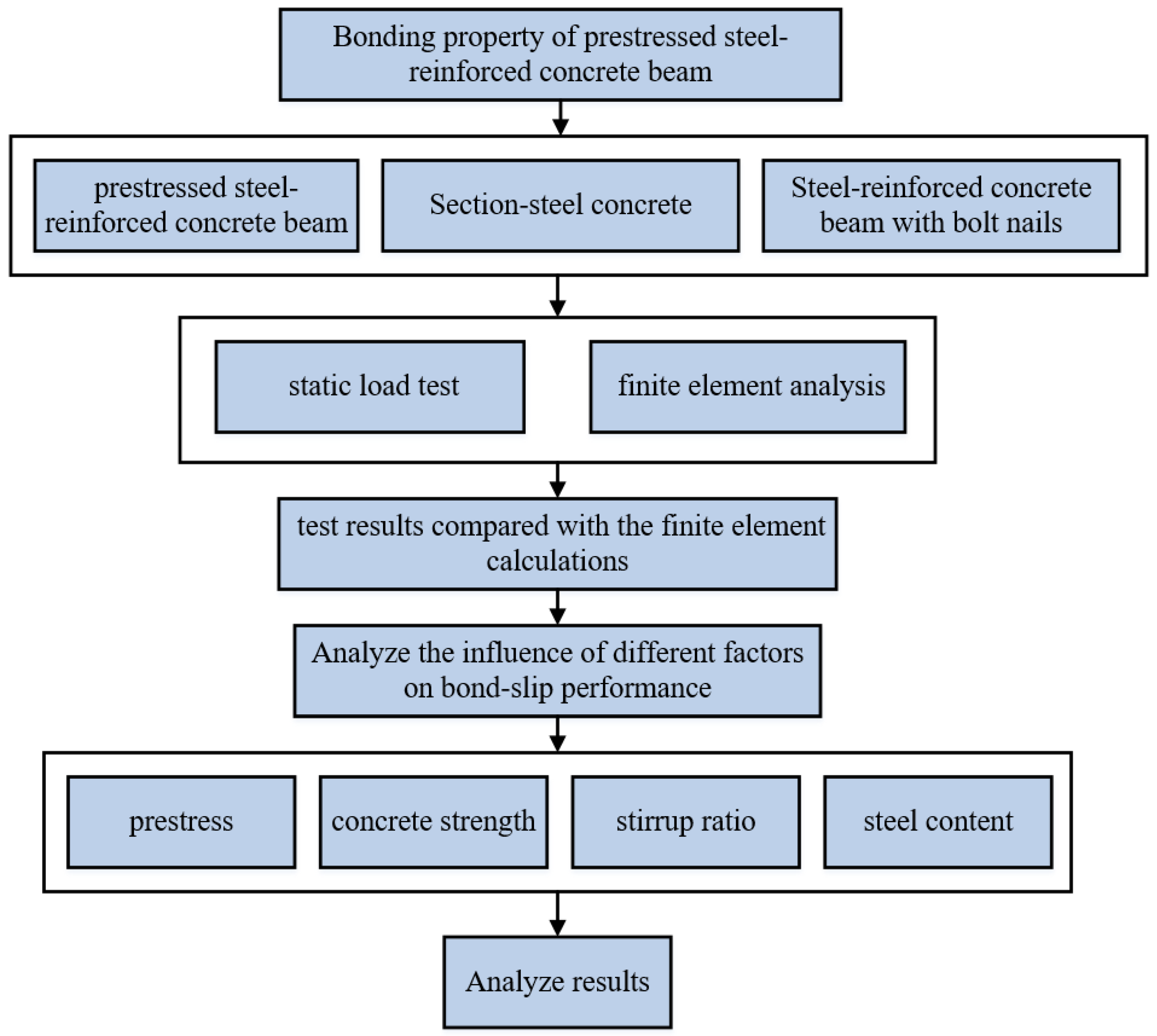

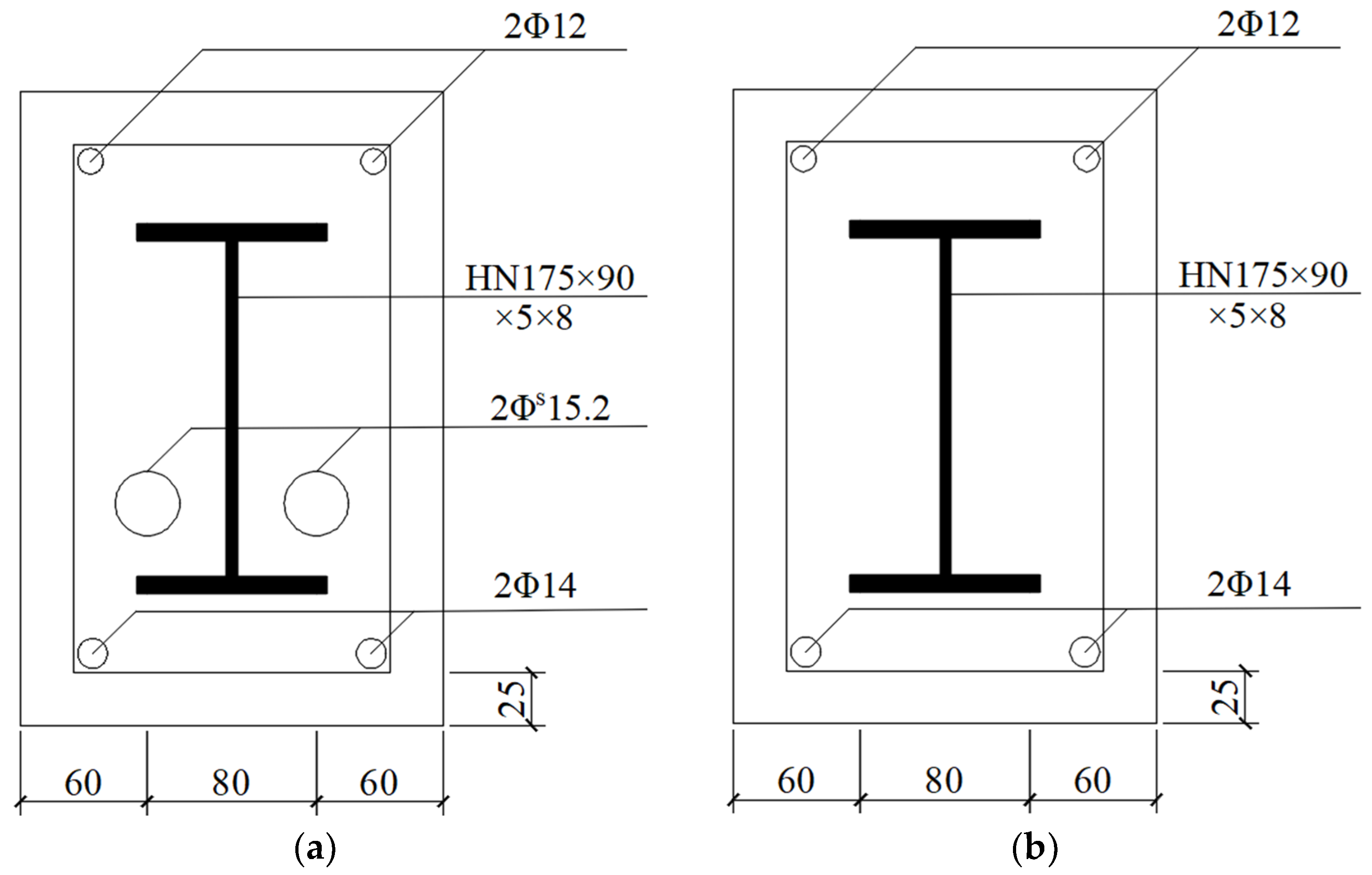


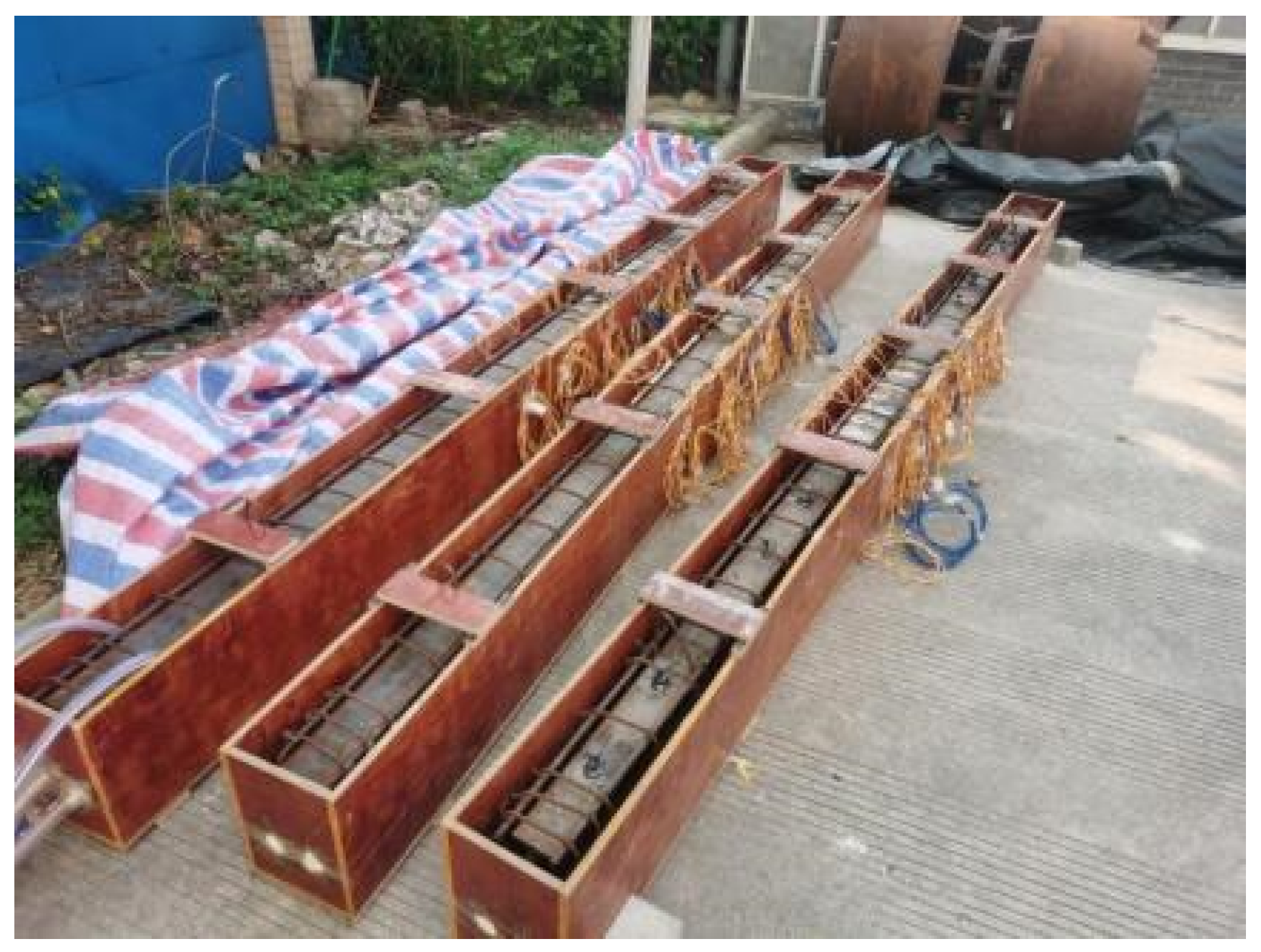
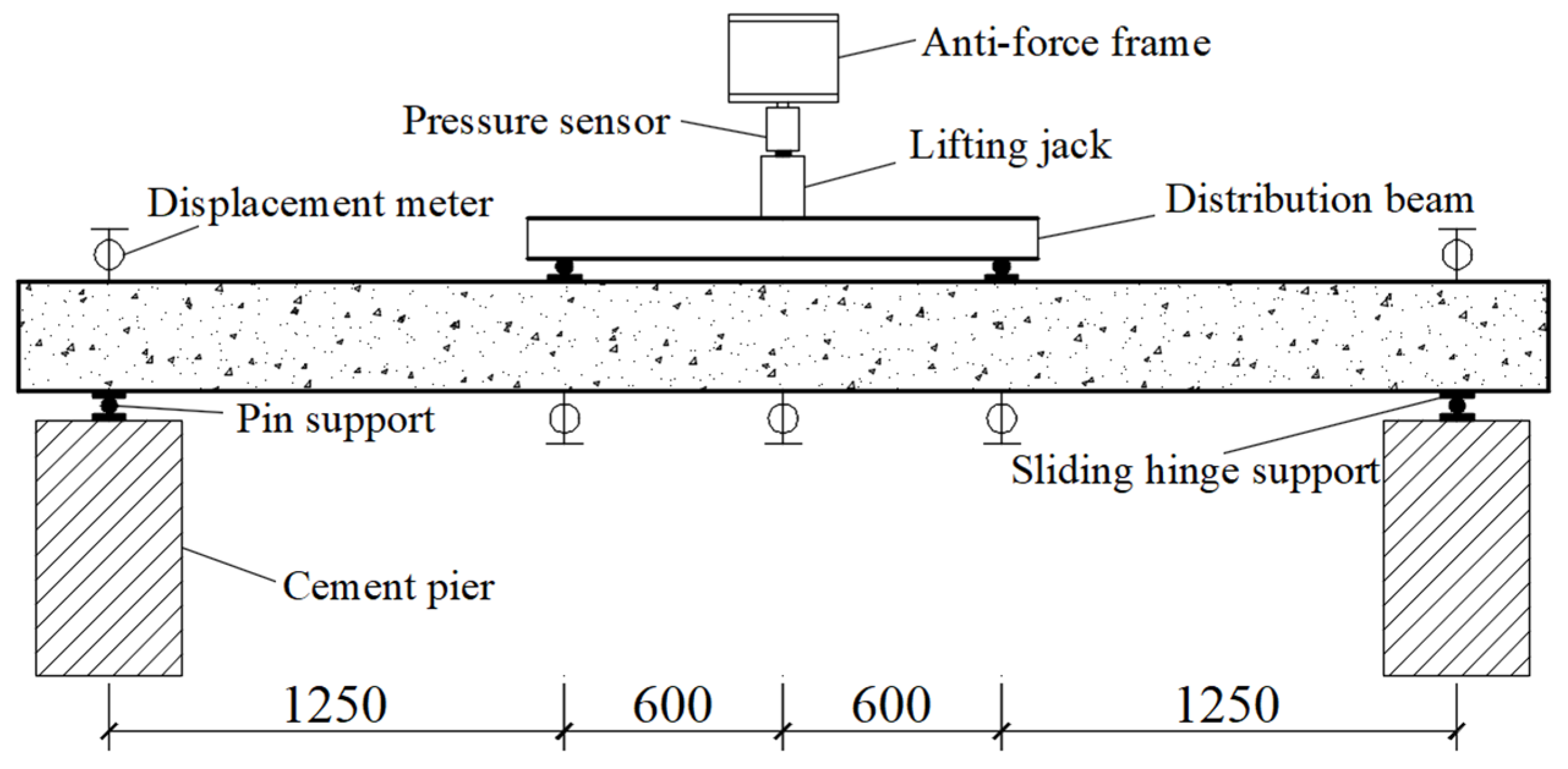
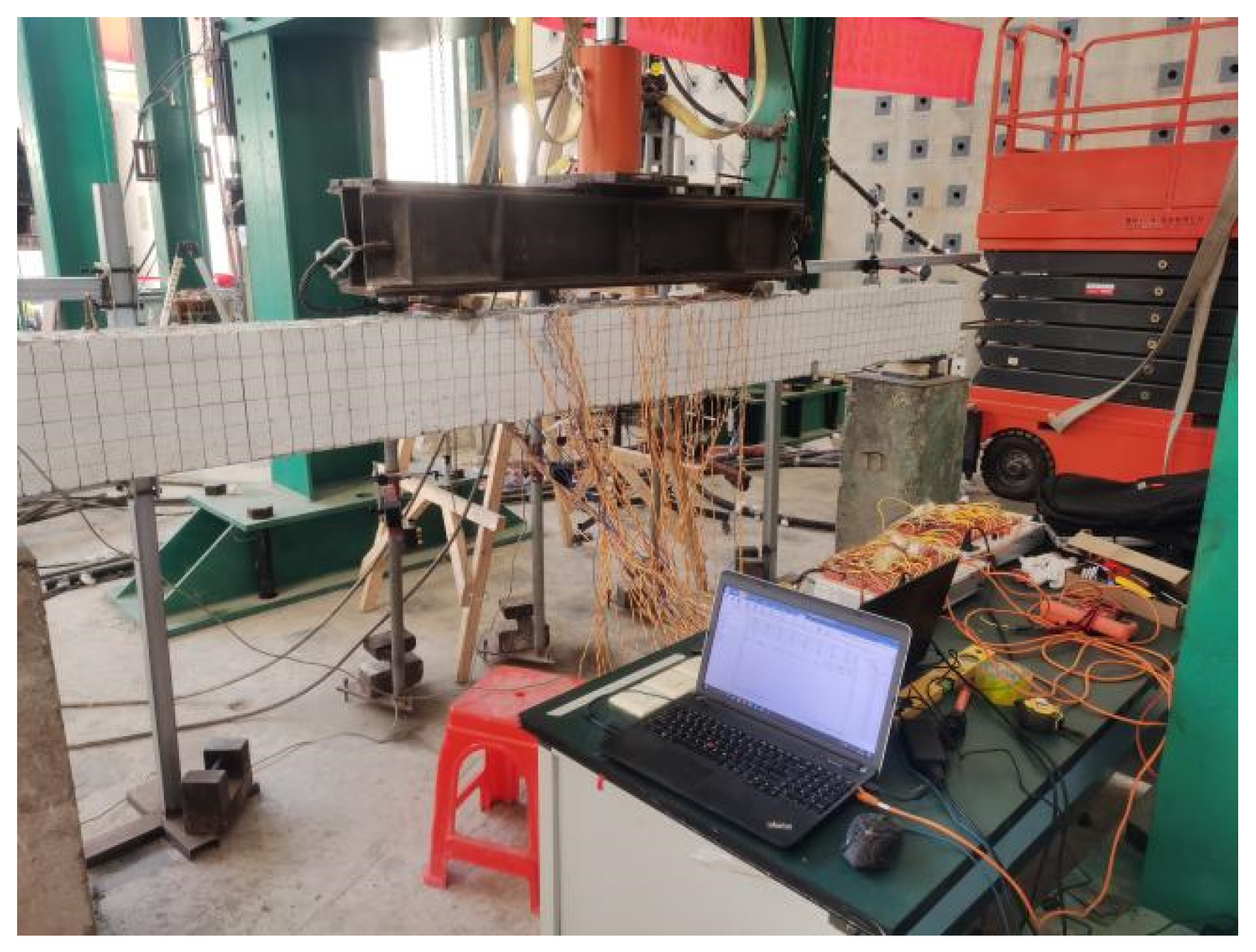
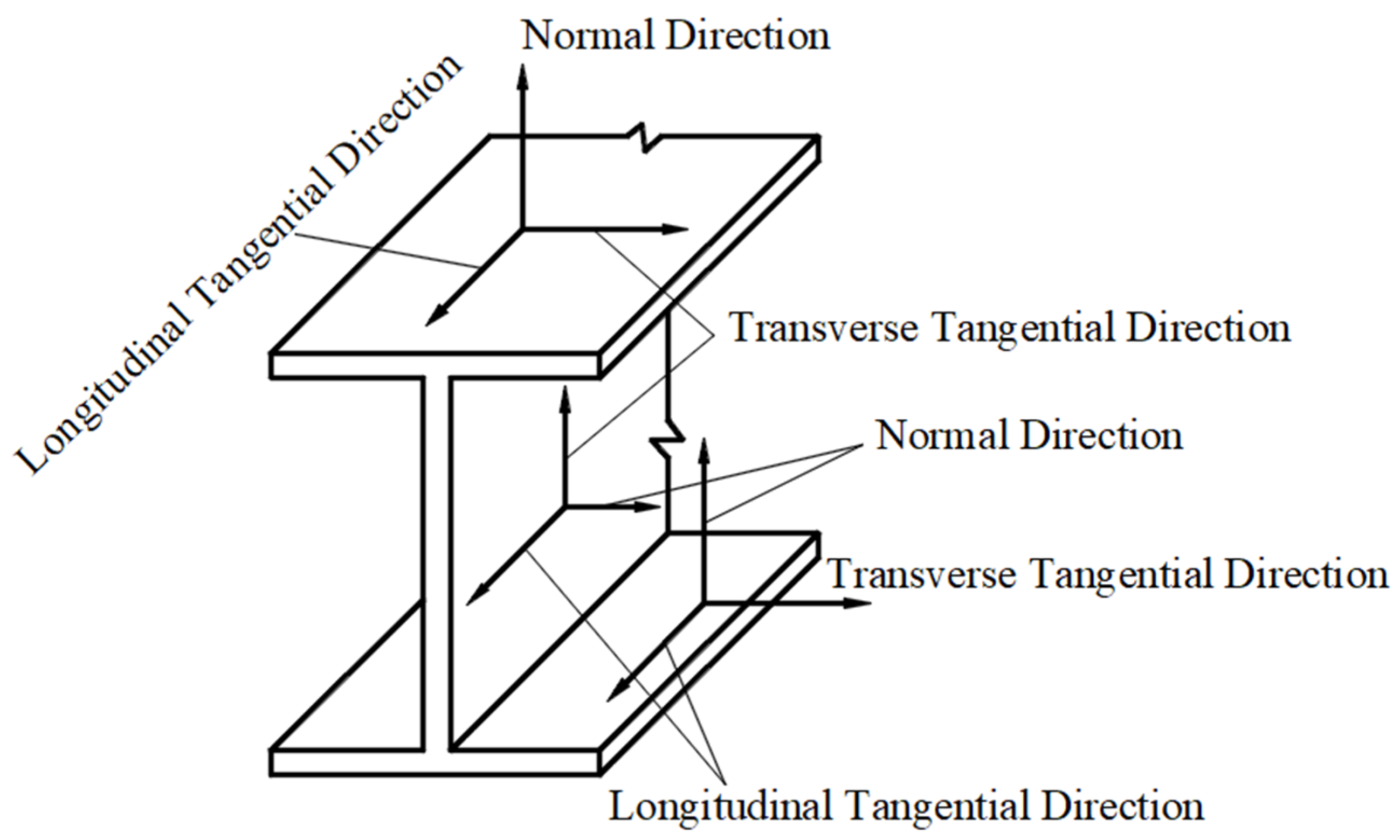

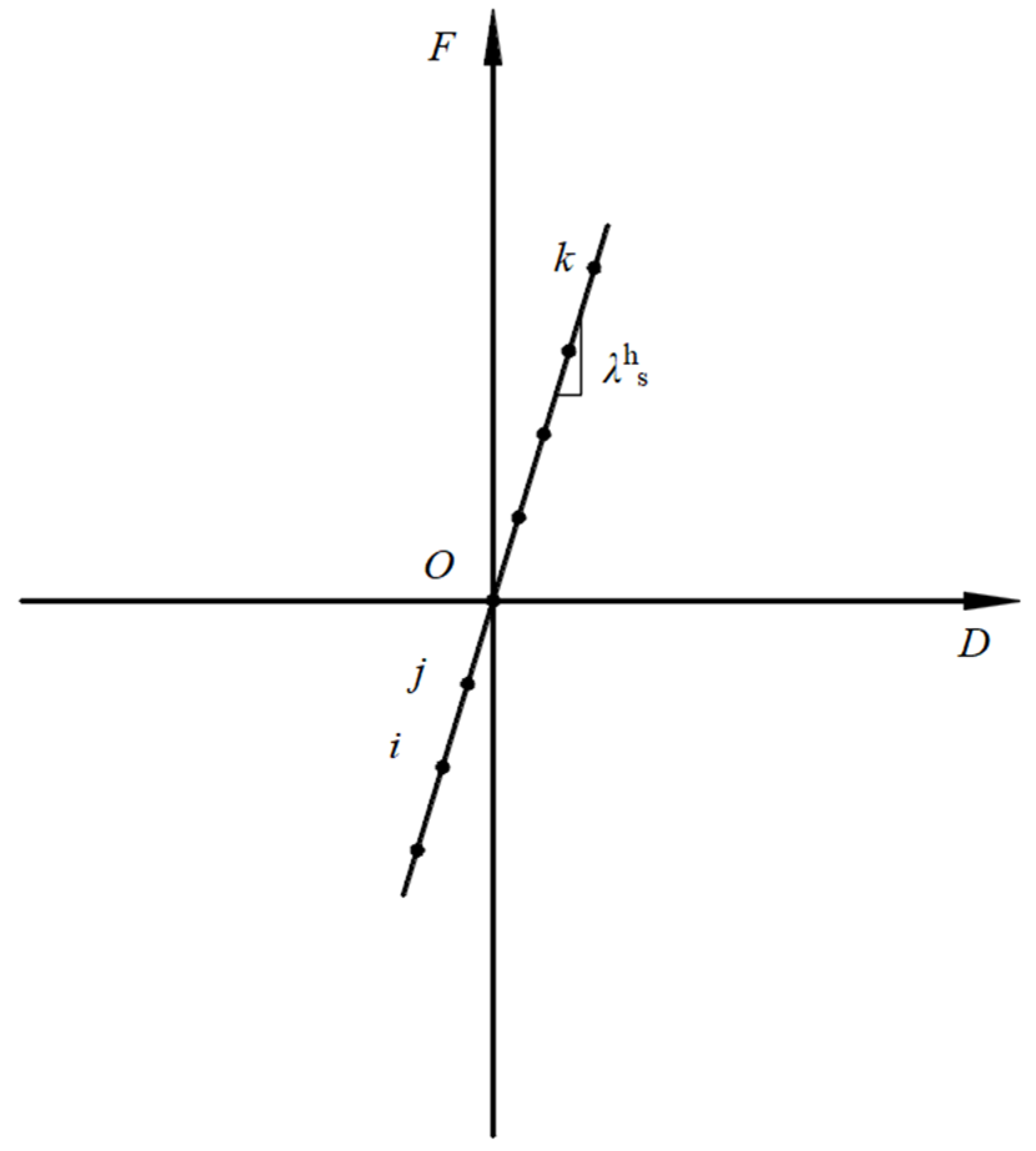
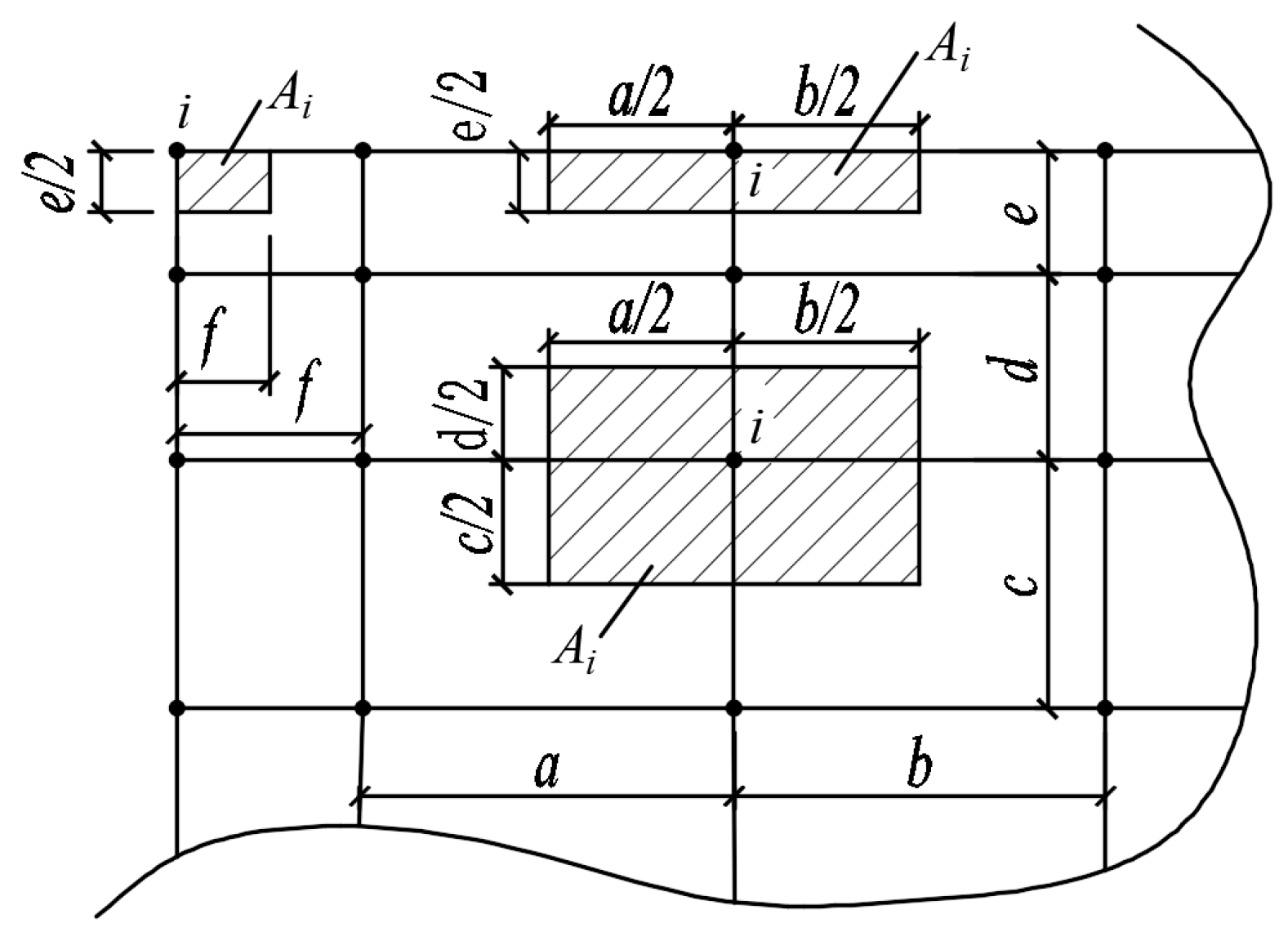
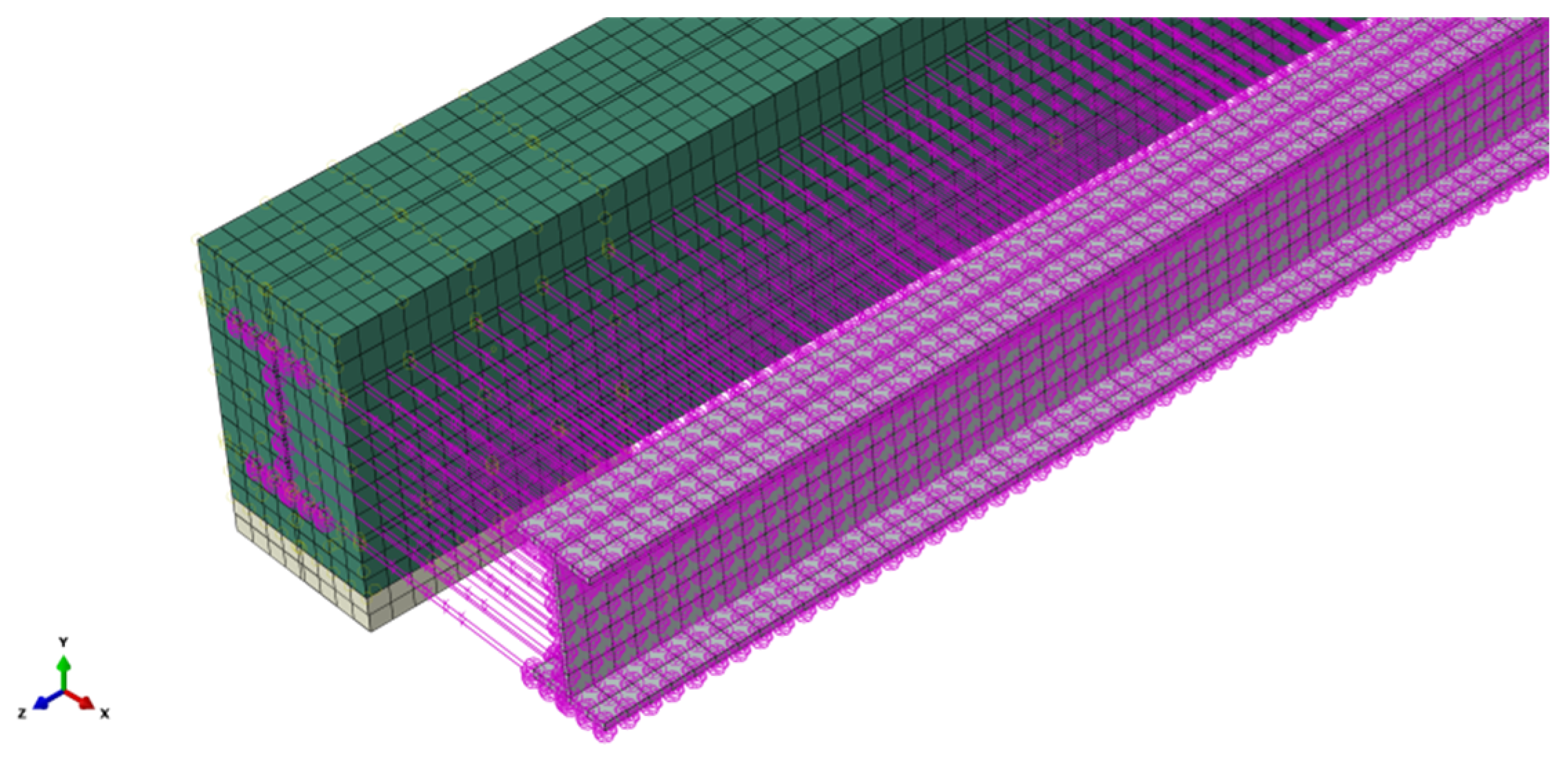

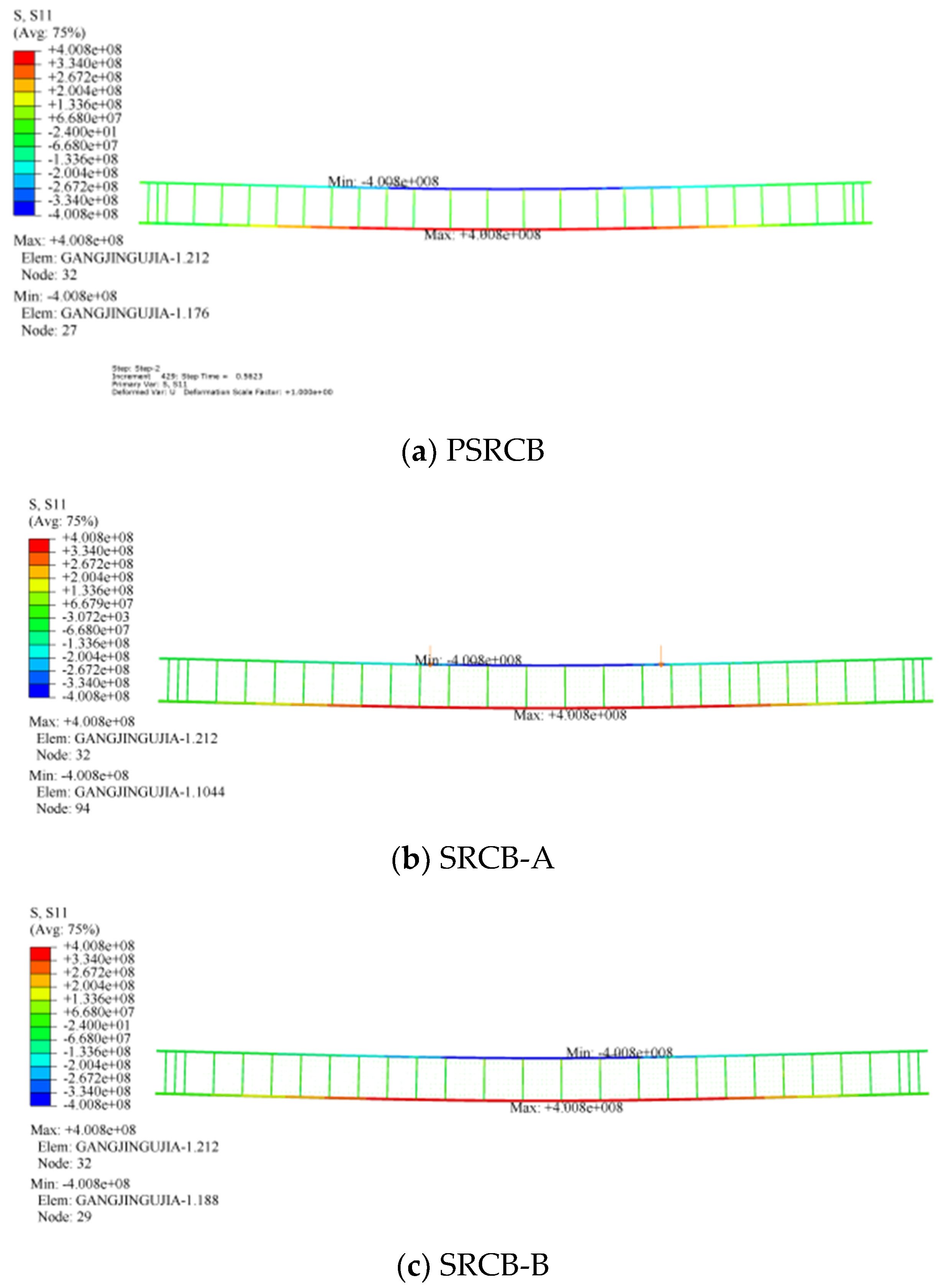




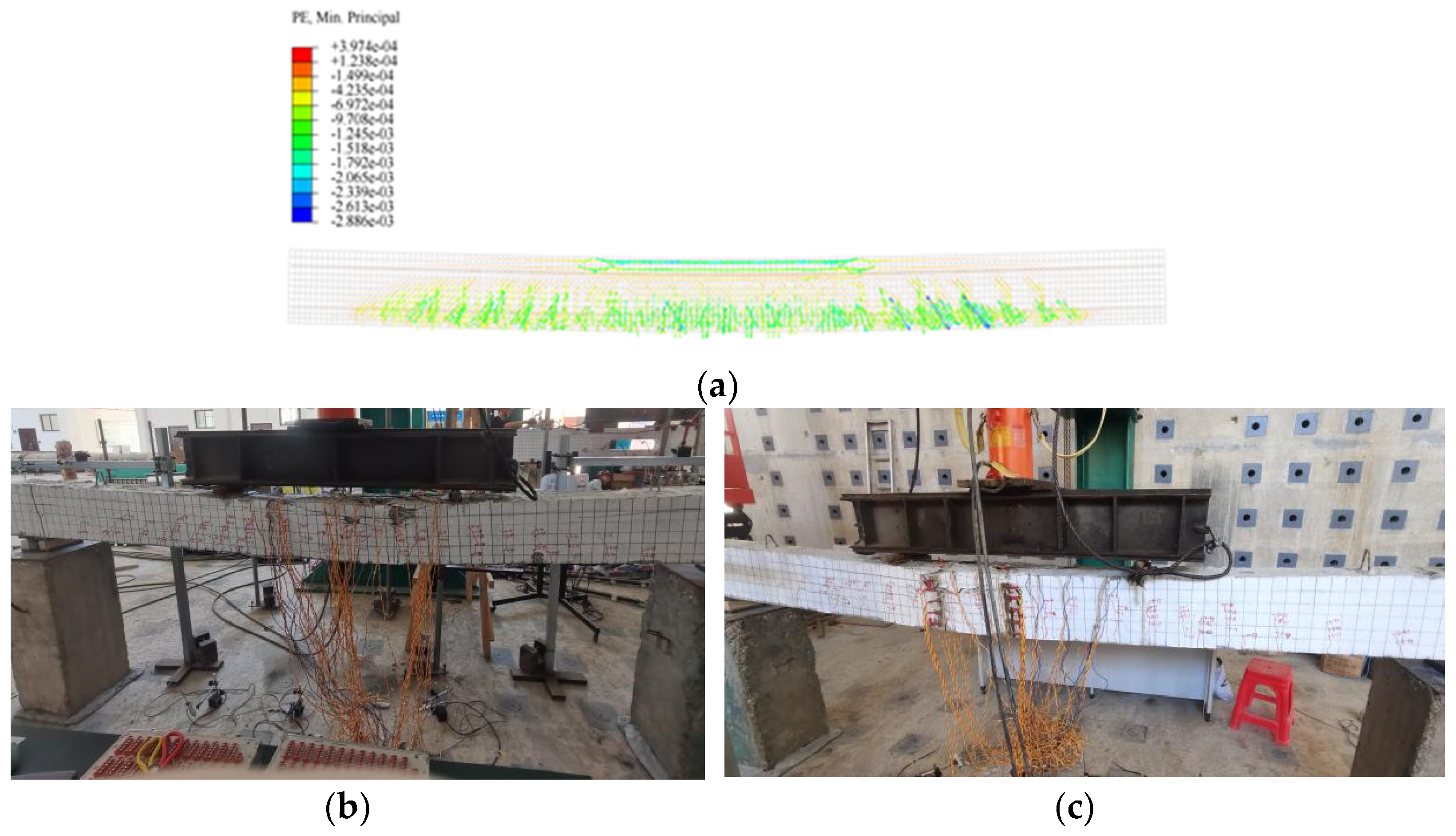
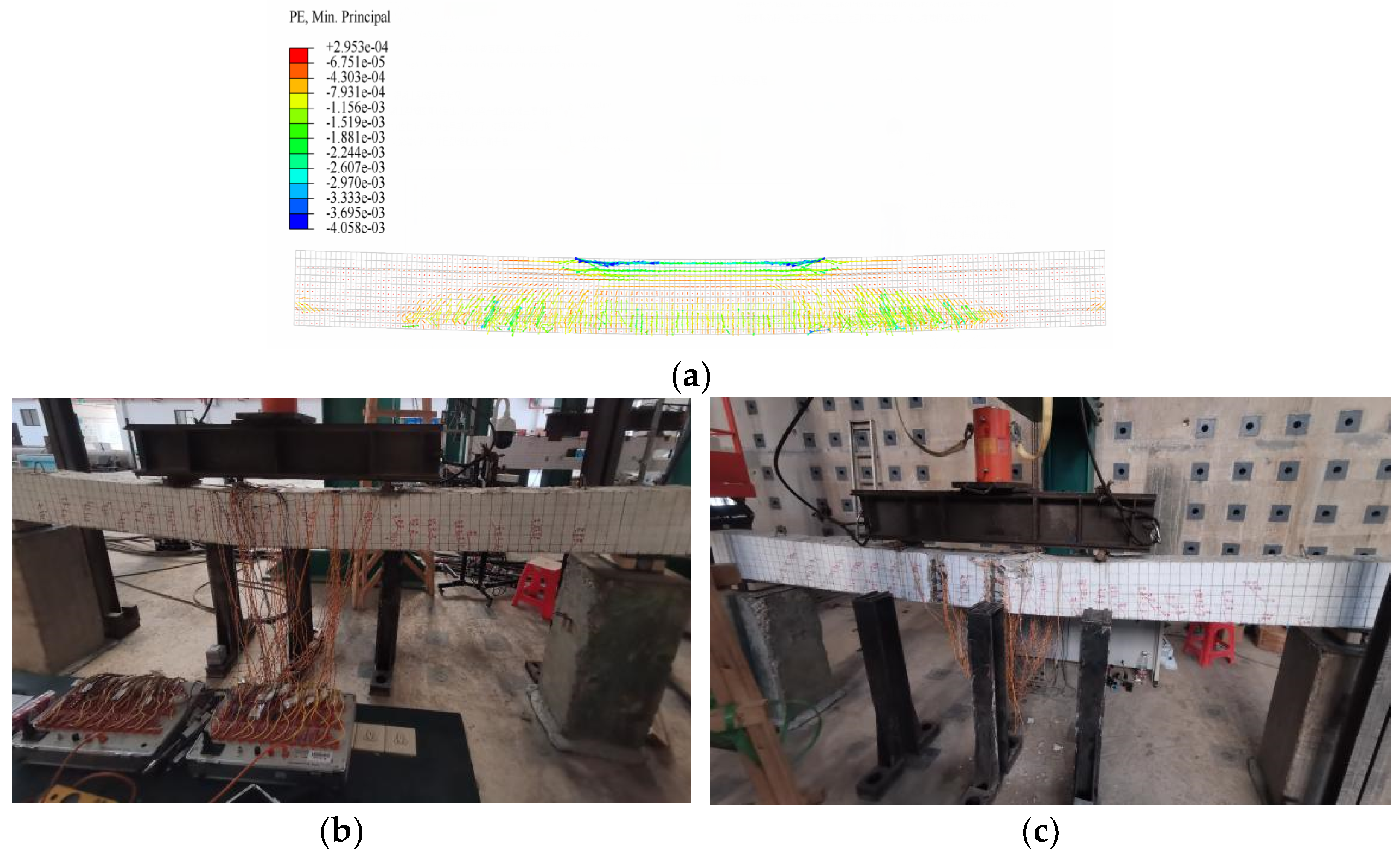
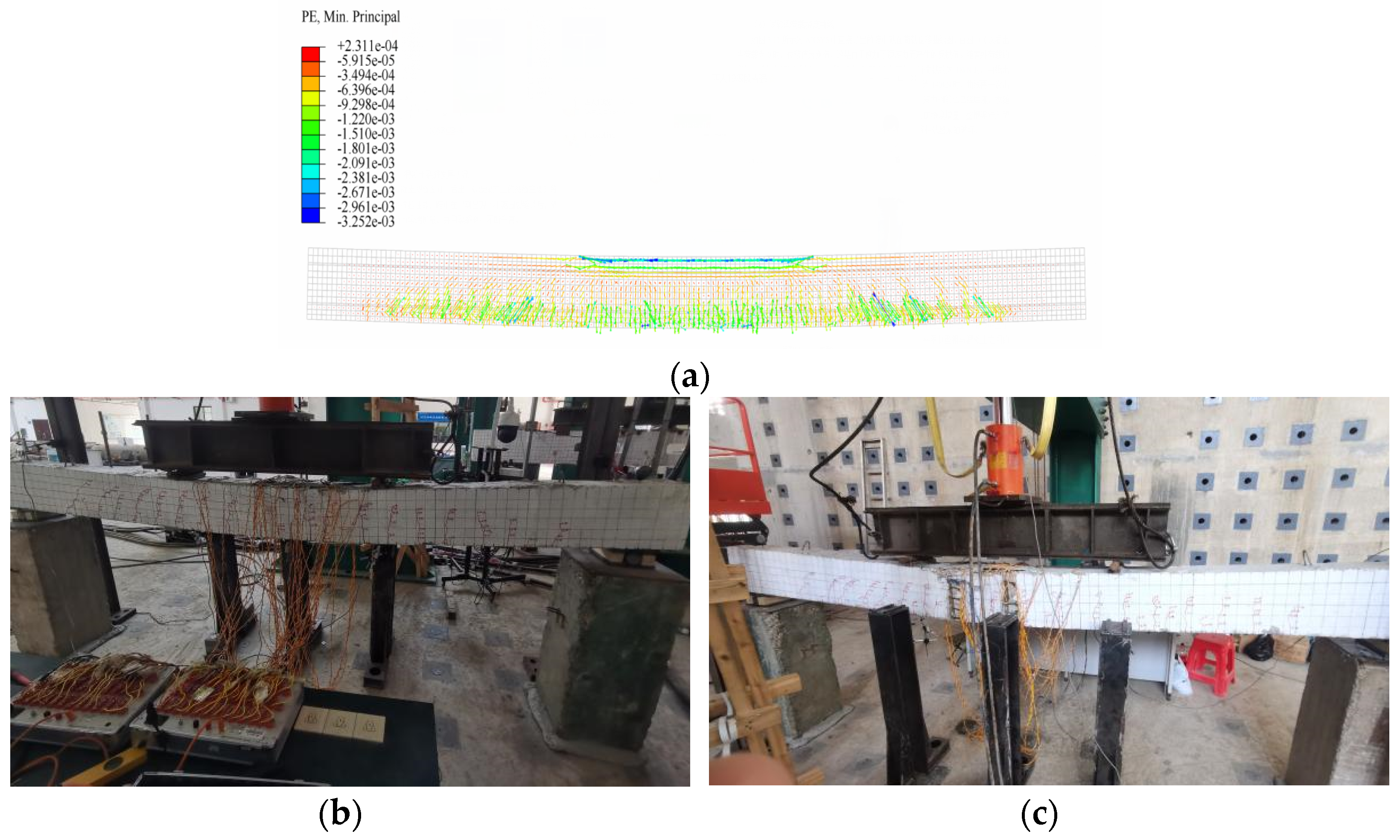


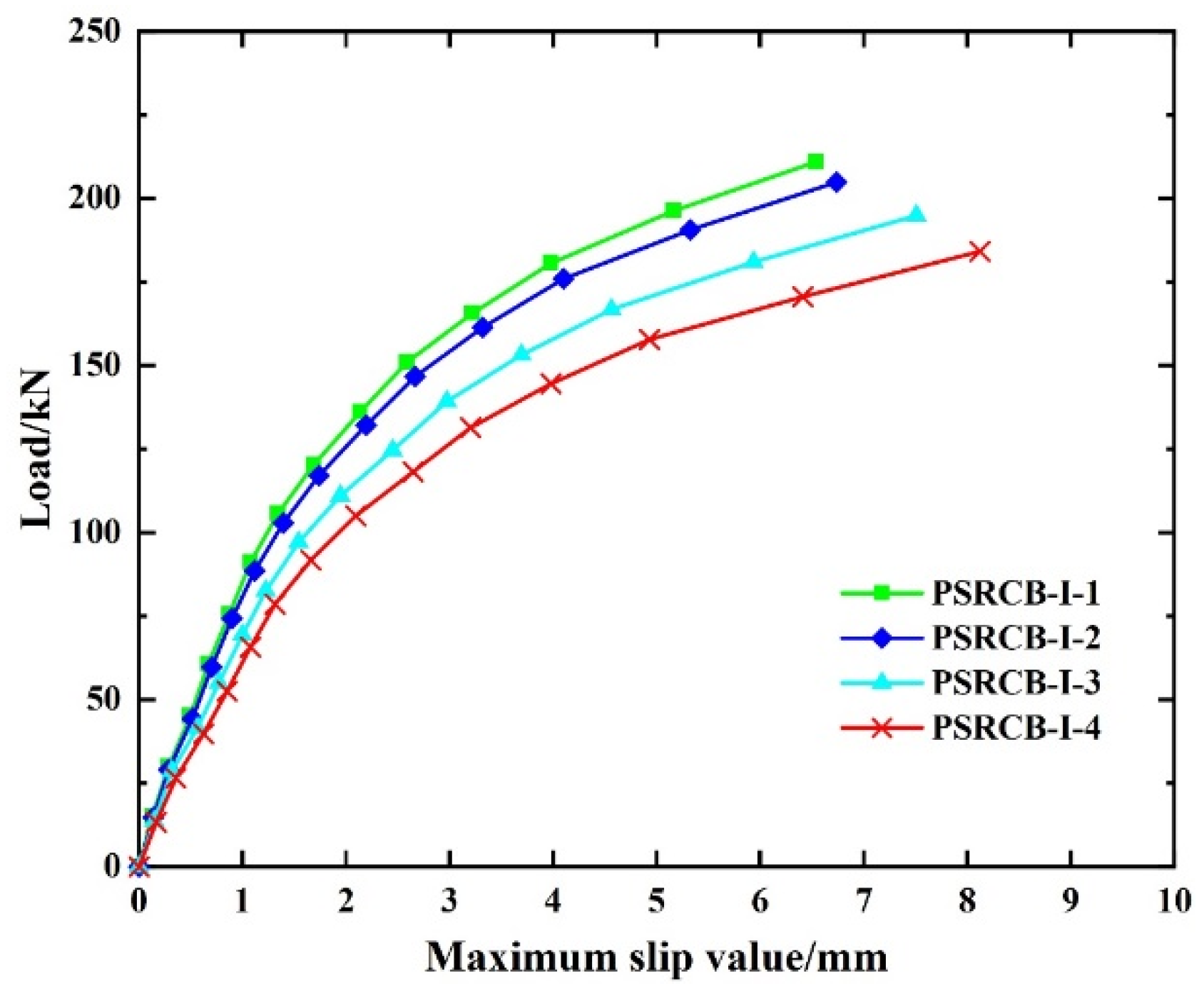

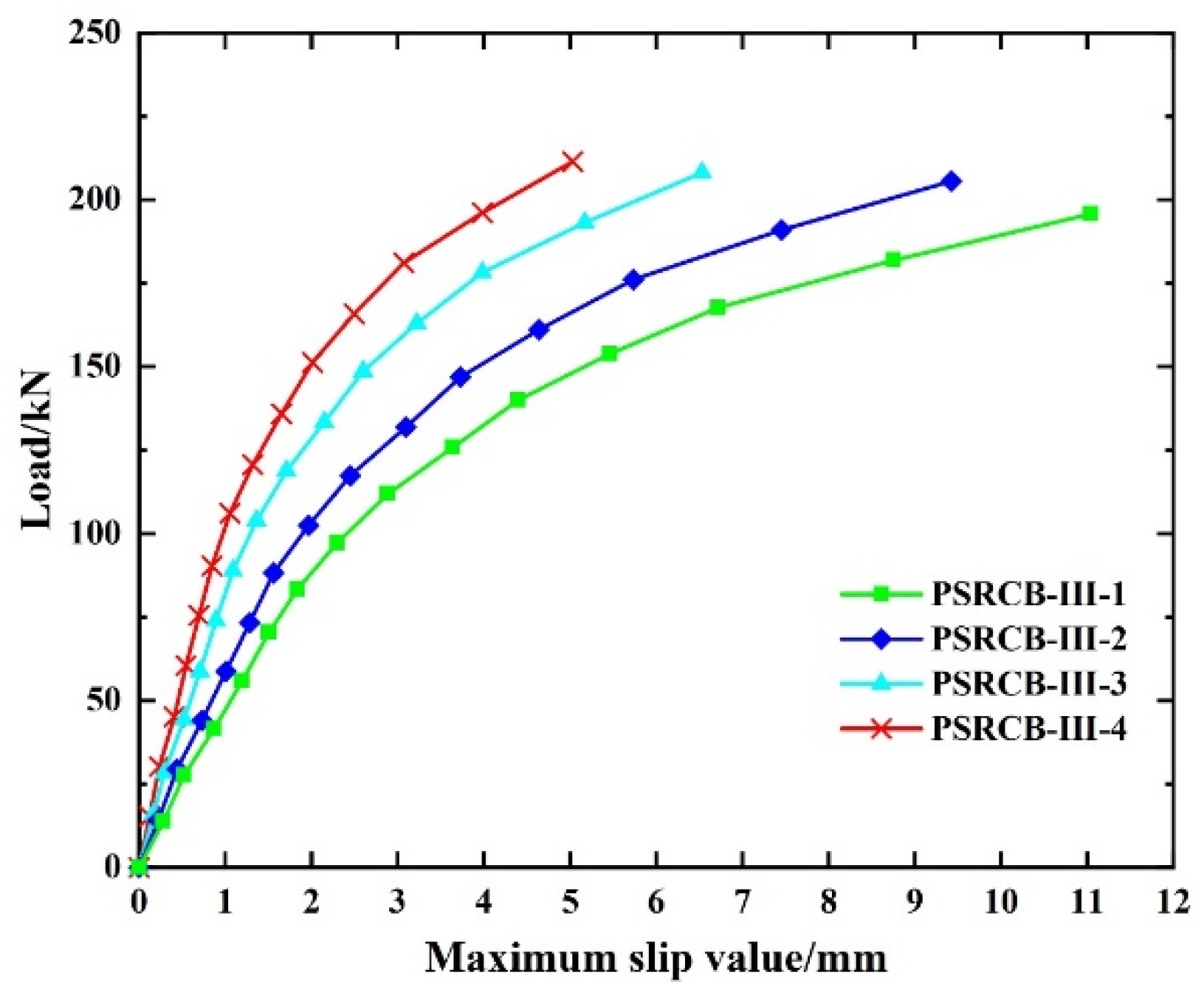

| Strength Grade of Concrete | fcu/MPa | fc/MPa | ft/MPa | Ec/MPa |
|---|---|---|---|---|
| C40 | 42.21 | 27.31 | 2.85 | 3.44 × 104 |
| Steel Type | Nominal Diameter/mm | Yield Strength/MPa | Ultimate Strength/MPa |
|---|---|---|---|
| Steel strand | 15.2 | 1574 | 1889 |
| HPB300 | 8 | 337 | 461 |
| HRB400 | 12 | 403 | 564 |
| HRB400 | 14 | 409 | 578 |
| Q345 | — | 347 | 504 |
| Cracking Load/kN | |||||||
|---|---|---|---|---|---|---|---|
| Specimen Type | Test Value | Calculated Value (Without Bond Slip) | Calculated Value (Bond–Slip Constitutive Relation A) | Calculated Value (Bond–Slip Constitutive Relation B) | Test Value/Calculated Value (Without Bond Slip) | Test value/Calculated Value (Bond–Slip Constitutive Relation A) | Test Value/Calculated Value (Bond–Slip Constitutive Relation B) |
| PSRCB | 72.4 | 85.91 | 78.33 | 74.65 | 0.843 | 0.924 | 0.970 |
| SRCB-A | 21.3 | 27.17 | 23.68 | 22.15 | 0.783 | 0.899 | 0.962 |
| SRCB-B | 23.6 | 31.37 | 27.45 | 25.26 | 0.752 | 0.860 | 0.934 |
| Ultimate Load/kN | |||||||
|---|---|---|---|---|---|---|---|
| Specimen Type | Test Value | Calculated Value (Without Bond Slip) | Calculated Value (Bond–Slip Constitutive Relation A) | Calculated Value (Bond–Slip Constitutive Relation B) | Test Value/Calculated Value (Without Bond Slip) | Test Value/Calculated Value (Bond–Slip Constitutive Relation A) | Test Value/Calculated Value (Bond–Slip Constitutive Relation B) |
| PSRCB | 193.6 | 207.86 | 200.78 | 194.74 | 0.931 | 0.964 | 0.994 |
| SRCB-A | 182.6 | 201.93 | 193.24 | 187.42 | 0.904 | 0.945 | 0.974 |
| SRCB-B | 184.7 | 205.57 | 197.40 | 190.73 | 0.898 | 0.936 | 0.968 |
| (a) | ||||
| Model number | PSRCB-I-1 | PSRCB-I-2 | PSRCB-I-3 | PSRCB-I-4 |
| Effective preload | 279.61 kN | 260.47 kN | 241.34 kN | 222.15 kN |
| (b) | ||||
| Model number | PSRCB-II-1 | PSRCB-II-2 | PSRCB-II-3 | PSRCB-II-4 |
| Concrete strength | 37.21 MPa | 40.99 MPa | 44.51 MPa | 47.97 MPa |
| (c) | ||||
| Model number | PSRCB-III-1 | PSRCB-III-2 | PSRCB-III-3 | PSRCB-III-4 |
| Hoop ratio | 0.25% | 0.34% | 0.42% | 0.50% |
| (d) | ||||
| Model number | PSRCB-IV-1 | PSRCB-IV-2 | PSRCB-IV-3 | PSRCB-IV-4 |
| Steel content | 3.37% | 3.94% | 4.70% | 5.41% |
| Model Number | Bond Slip Is Not Considered | Bond Slip Is Considered | Deviation |
|---|---|---|---|
| PSRCB-I-1 | 227.84 | 210.96 | 7.41% |
| PSRCB-I-2 | 223.12 | 204.84 | 8.19% |
| PSRCB-I-3 | 215.94 | 195.10 | 9.65% |
| PSRCB-I-4 | 207.76 | 183.69 | 11.59% |
| Model Number | Bond Slip Is Not Considered | Bond Slip Is Considered | Deviation |
|---|---|---|---|
| PSRCB-II-1 | 227.84 | 210.96 | 7.41% |
| PSRCB-II-2 | 234.98 | 220.91 | 5.97% |
| PSRCB-II-3 | 242.38 | 230.84 | 4.76% |
| PSRCB-II-4 | 252.78 | 243.06 | 3.85% |
| Model Number | Bond Slip Is Not Considered | Bond Slip Is Considered | Deviation |
|---|---|---|---|
| PSRCB-III-1 | 222.48 | 195.64 | 12.06% |
| PSRCB-III-2 | 226.70 | 205.27 | 9.45% |
| PSRCB-III-3 | 227.18 | 207.95 | 8.46% |
| PSRCB-III-4 | 227.84 | 210.96 | 7.41% |
| Model Number | Bond Slip Is Not Considered | Bond Slip Is Considered | Deviation |
|---|---|---|---|
| PSRCB-IV-1 | 215.42 | 204.23 | 5.19% |
| PSRCB-IV-2 | 227.84 | 210.96 | 7.41% |
| PSRCB-IV-3 | 238.21 | 217.55 | 8.67% |
| PSRCB-IV-4 | 245.02 | 222.89 | 9.03% |
Disclaimer/Publisher’s Note: The statements, opinions and data contained in all publications are solely those of the individual author(s) and contributor(s) and not of MDPI and/or the editor(s). MDPI and/or the editor(s) disclaim responsibility for any injury to people or property resulting from any ideas, methods, instructions or products referred to in the content. |
© 2024 by the authors. Licensee MDPI, Basel, Switzerland. This article is an open access article distributed under the terms and conditions of the Creative Commons Attribution (CC BY) license (https://creativecommons.org/licenses/by/4.0/).
Share and Cite
Deng, N.; Li, W.; Du, L.; Deng, Y. Nonlinear Analysis of Prestressed Steel-Reinforced Concrete Beams Based on Bond–Slip Theory. Buildings 2024, 14, 2648. https://doi.org/10.3390/buildings14092648
Deng N, Li W, Du L, Deng Y. Nonlinear Analysis of Prestressed Steel-Reinforced Concrete Beams Based on Bond–Slip Theory. Buildings. 2024; 14(9):2648. https://doi.org/10.3390/buildings14092648
Chicago/Turabian StyleDeng, Nianchun, Wujun Li, Linyue Du, and Yanfeng Deng. 2024. "Nonlinear Analysis of Prestressed Steel-Reinforced Concrete Beams Based on Bond–Slip Theory" Buildings 14, no. 9: 2648. https://doi.org/10.3390/buildings14092648





